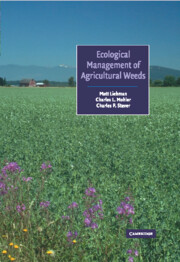Book contents
- Frontmatter
- Contents
- Preface
- 1 Weed management: a need for ecological approaches
- 2 Weed life history: identifying vulnerabilities
- 3 Knowledge, science, and practice in ecological weed management: farmer–extensionist–scientist interactions
- 4 Mechanical management of weeds
- 5 Weeds and the soil environment
- 6 Enhancing the competitive ability of crops
- 7 Crop diversification for weed management
- 8 Managing weeds with insects and pathogens
- 9 Livestock grazing for weed management
- 10 Weed evolution and community structure
- 11 Weed management: the broader context
- Taxonomic index
- Subject index
4 - Mechanical management of weeds
Published online by Cambridge University Press: 10 November 2009
- Frontmatter
- Contents
- Preface
- 1 Weed management: a need for ecological approaches
- 2 Weed life history: identifying vulnerabilities
- 3 Knowledge, science, and practice in ecological weed management: farmer–extensionist–scientist interactions
- 4 Mechanical management of weeds
- 5 Weeds and the soil environment
- 6 Enhancing the competitive ability of crops
- 7 Crop diversification for weed management
- 8 Managing weeds with insects and pathogens
- 9 Livestock grazing for weed management
- 10 Weed evolution and community structure
- 11 Weed management: the broader context
- Taxonomic index
- Subject index
Summary
Introduction
Physical removal of weeds by soil disturbance prior to planting, and by hoeing and hand-weeding during crop growth are undoubtedly the oldest forms of agricultural weed management. Farmers and agricultural equipment manufacturers continue to develop this ancient tradition of mechanical weed control through the refinement of hand tools and the invention of new tillage and weeding machinery. The purpose of this chapter is to explore the ways in which tillage before crop planting and mechanical weed control methods after planting interact with the ecology of weeds, and to use that understanding to suggest strategies for weed management.
Tillage and cultivation affect weeds in three distinct ways. First, they uproot, dismember, and bury growing weeds and dormant perennating organs. Second, they change the soil environment in ways that can promote germination and establishment of weeds or, less commonly, inhibit germination and establishment. Third, they move weed seeds vertically and horizontally, and this affects the probability that seedlings emerge, survive, and compete with the crop. The second of these effects was discussed in Chapter 2. The first and third are addressed in this chapter.
Each of the tools used for tillage and cultivation disturbs the soil in a unique way. In particular, tools vary with respect to their working depth and the degree to which they invert the soil column, break up soil aggregates, and shake weed roots free from the soil.
- Type
- Chapter
- Information
- Ecological Management of Agricultural Weeds , pp. 139 - 209Publisher: Cambridge University PressPrint publication year: 2001
- 39
- Cited by



